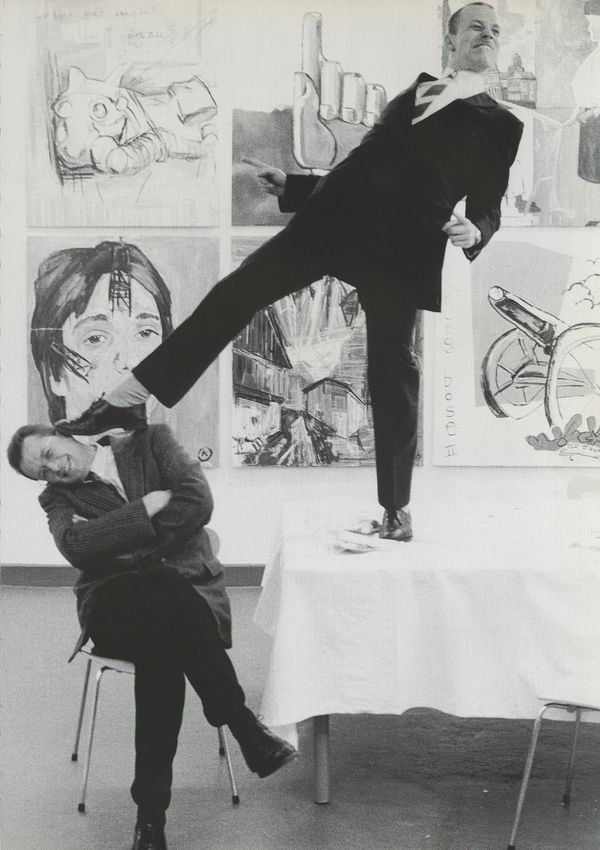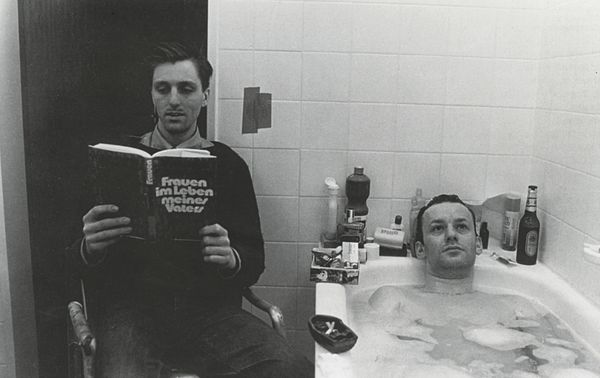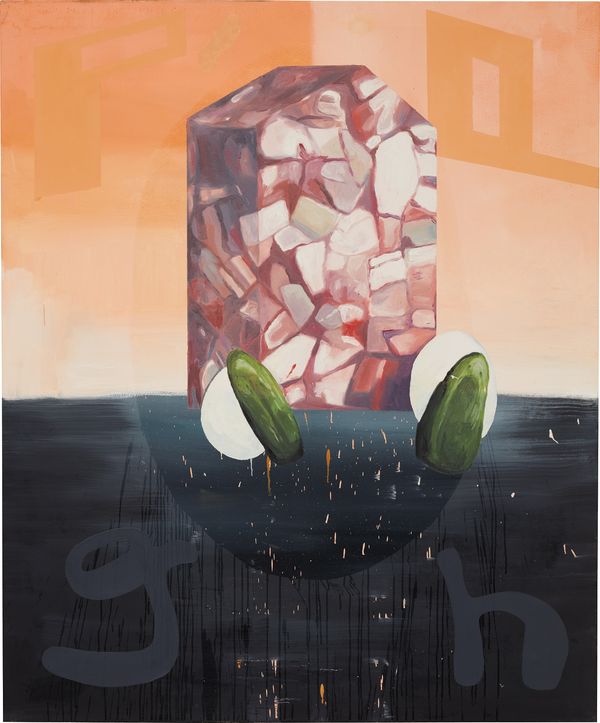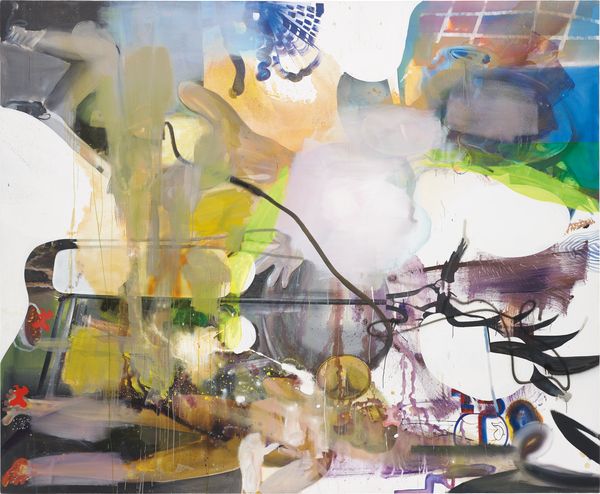Invitation card Women in the life of my father, Gallery Erhard Klein, Bonn. Scene after Jean-Luc Godard’s film Le mépris, 1963. Image: Bernhard Schaub.
Martin Kippenberger and Albert Oehlen are among the most iconic German artists of the past century. Emerging from a generation ridden with national and political disillusionment, they navigated controversial subjects with artistic levity. Through their satirical and outlandish humor, Oehlen and Kippenberger investigated the current generational culture of their homeland of Germany. As art historian Gregory H. Williams has observed regarding the prevalence of wit in German art of the 1980’s, "for a nation confronting a horrifc period from its recent past, the embrace of laughter must be considered as a radical response to matters of a most serious nature." (Gregory H. Williams, Permission to Laugh: Humor and Politics in Contemporary German Art, 2012, p. 11)

Martin Kippenberger with Max Hetzler after an opening of Reinhard Mucha in front of the painting 8 pictures to think about whether we can keep this up, Max Hetzler Gallery, Cologne, 1983. Image: Wilhelm Schürmann Artwork: © 2016 Estate Martin Kippenberger, Galerie Gisela Capitain, Cologne.
The past resonates as a consistent theme in Kippenberger’s paintings of the 1980’s, exemplifed by Plusquamperfekt - gehabt haben (Past Perfect - have had), 1984. The title alone emphasizes the grammatical past and past perfect tenses, which function to distinguish the particular order of past events. Kippenberger’s titles act as clues to an unsolvable visual puzzle. The tension of the "have had" of the title echoes the resistant connection between the composition and the text.
A simplistic house stands at the center of the composition; the foursided structure is a reference to fellow German artist Hubert Kiecol’s Standardhausers. Kiecol exhibited his small concrete houses, stairs and other architectural models at Galerie Max Hetzler in 1984, the same year that Plusquamperfekt - gehabt haben (Past Perfect - have had) was painted. Kiecol’s scaled down architectural forms investigate the nature of home and security.
Martin Kippenberger Plusquamperfekt - gehabt haben (Past Perfect - have had), 1984.
Kippenberger’s appropriated Standardhauser is made of brawn and is accompanied by two of his iconic white eggs and vibrant green pickles or German gherkins. The egg for Kippenberer references rebirth, reproduction and the natural cycle in the form of a comical artistic symbol. The lower quadrant of the composition is a sea of charcoal black upon which a "g" and an "h"—referencing gehabt haben in the title—can be faintly made out, as though drawn into the paint with his pointer fnger.
For both Kippenberger and Oehlen, the canvas became a plate upon which to serve their colorful cultural commentary, constantly shifting between stinging criticism and playful wit as can be seen in Oehlen’s painting entitled Lämmle live. The work was painted in 2004, the year that the television show Lämmle live ended its nine year run. The program played live every Saturday night and featured Brigitte Lämmle, a psychologist who dispensed advice to viewers calling into her show seeking personal guidance.
Brigitte’s appearance is often commented upon: her loose frizzy hair, thickly knit wool sweaters, tweed skirts and box-like sneakers established her as the embodiment of comfort. Over 15,000 people called in every Saturday night while only ten were selected to be on the talk show to share their most intimate personal struggles.
For both Kippenberger and Oehlen, the canvas became a plate upon which to serve their colorful cultural commentary, constantly shifting between stinging criticism and playful wit...
Albert Oehlen Lämmle live, 2004.
This reference to the exposure of inner turmoil is visually illustrated in Lämmle live, as Oehlen draws art historical references to the palette of his teacher Sigmar Polke, while the cacophony of smudges and drips calls upon the active compositions of his friend and fellow painter Christopher Wool. Within the scene, half-obscured figures are discernable. The face of a man with small wire rim glasses in the upper right quadrant, the legs and feet of a figure donning very Brigitte-esque white thick socks and sneakers at the upper left, and the full body of a man speaking through a megaphone runs horizontality along the lower left edge of the canvas.
This chaotic storm of imagery could perhaps allude to the mental states of Lämmle live’s callers, all desperately seeking a quick fix to their pressing problem. The painting may stand as an homage to the female mentor or a criticism of the gimmicky, media-based form of psychological advice that was dispersed so haphazardly to the public.
This visual tangle of human forms and geometric swaths of paint has been aptly described by curator Michael Clark, citing Oehlen as an artist who "has painted himself into a position where none of his canvases can be described as either abstract or figurative… Freed from any notion of formal repetition, of content or theme, he is able to investigate, question, experiment and play in the plastic cosmology—the very material and matter—that constitutes and defnes that universe." (Martin Clark, "Abstract Painting Must Die Now" in Albert Oehlen: I Will Always Champion Good Painting, 2006, p. 59)


